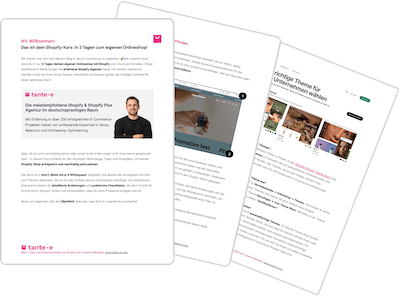At first glance, product variants on Shopify seem like a technical detail. In fact, they are one of the most strategically important decisions when building an online store.
This is where the distinction between real and so-called fake versions comes in. The choice significantly influences key areas such as usability, conversion, maintenance effort, cross-selling, discounts, SEO, and thus the success of your entire store.
In the podcast, our expert Nina talks in detail about the available options, how the two strategies differ, and when each approach proves successful in practice. We summarize the most important learnings and practical insights from XbyX in this article.

Nina is an account manager at tante-e and has extensive experience working with various e-commerce brands on an ongoing basis. She regularly shares her knowledge in the tante-e podcast, including on sets and bundles and the right variant management on Shopify.
- Why the right strategy matters when it comes to product variants on Shopify
- Real Variants on Shopify: The Standard Approach
- Fake variants: Flexibility in presentation, content and SEO
- Practical example xbyx: Two levels of fake variants successfully implemented
- Decision-making aid: When are real variants and when are fake variants?
- Conclusion: Recommendations from practice
1. Why the right strategy matters when it comes to product variants on Shopify
Almost every Shopify store uses product variants. Many products come in different configurations, such as size, color, or flavor. How these variants are created and displayed has a direct impact on various aspects of your store:
Impact on the user experience
- Can users easily switch between product variants?
- Is it visually clear what options are available?
- Does the overview remain intact – even with a larger range of variants?
Influence on the conversion rate
- Can users quickly find the right product?
- Is what contributes to the purchase decision presented specifically?
- Do presentation and usability have a positive effect on the likelihood of purchase?
Relevance for maintenance and scalability
- How difficult is it to create and update variants?
- How flexible can bundles, cross-sells or promotions be implemented at the variant level?
- Is the setup compatible with existing systems, such as ERP or PIM?
Importance for visibility in search engines
- Can specific variants be indexed specifically?
- Can the product catalog be structured in such a way that diversity is visible even at the category level?
- Is there control over the URL structure of individual variants?
The choice of variant model therefore influences not only the technical structure, but also the user experience and the economic performance of the shop as a whole.
2. Real Variants on Shopify: The Standard Approach
Shopify offers the ability to create product variants directly in the admin area. Up to three variant options (e.g., color, size, packaging) can be stored per product, with a total of up to 100 variant combinations.
Advantages
- Direct maintenance possible in the Shopify admin
- Variant change occurs without page reload
- Supported by many themes and Shopify-specific apps
- Ideal for products with limited variants and similar content structure
restrictions
- Limitation to three options and 100 combinations per product
- Only one image can be assigned per variant, all images will be loaded
- Variants share a product page, so individual content is only possible to a limited extent
- On category pages, only the main product is displayed, variants remain hidden
- No individual URL per variant – only parameter IDs in the URL
A classic example: A T-shirt with multiple colors and sizes is created as a product with variants. Users select the variant via swatch or dropdown. The visible page content remains unchanged, except for the image and price.
3. Fake variants: Flexibility in presentation, content and SEO
Fake variants are an alternative approach to managing product variants in Shopify. Instead of grouping multiple variants under one product, each variant is managed as a separate product in the system. In this case, a protein shake in three flavors is not managed as one product with three variants, but as three individual products, each with its own URL, description, and image selection.
This approach offers significantly more flexibility for design, content adaptation, and search engine optimization. At the same time, it presents new challenges, particularly in terms of maintenance effort and technical implementation. When is this approach worthwhile?
When fake variants on Shopify make sense
Overview on category pages
Since each variant is a separate product, it also appears separately on the category page. This makes the product range immediately visible to users. This is particularly advantageous for small product catalogs with a high variety of variants. For example, offering five colors of a T-shirt increases the visible selection in the shop at once.
Different content per variant
When product variants differ not only in price or color, but are intended to tell their own stories or communicate specific benefits, the fake variant approach offers maximum flexibility. Each variant can contain its own product description, images, testimonials, or even special offers.
Improved filter logic and user guidance
Shopify always displays the main product image for genuine variants on category pages or in filters. For example, if you filter by "red," a product with a red variant will appear in the results, but often with the image of the blue version. This can cause confusion. For fake variants, you can ensure that the correct version is actually displayed.
Independent URLs for targeted SEO
Each fake variant has its own product page and thus its own URL. This opens up new opportunities for targeted optimization. Pages like /proteinshake-waldfrucht or /t-shirt-dunkelblau can be precisely tailored to search terms and user intent. This isn't possible with real variants, as Shopify simply appends the variant ID via a URL parameter.
4. Practical example XbyX: Two levels of fake variants successfully implemented
A specific use case for fake versions is the Shopify store of XbyX, a brand for herbal nutritional supplements for midlife women. The product range includes protein shakes, collagen products, and vitamin supplements. The focus is not only on the product itself, but also on targeted communication about its mode of action, ingredients, and possible uses.

Why xbyx relies on fake variants
XbyX operates with a manageable product catalog, yet it encompasses a wide variety of options. Protein shakes, for example, are available in various flavors and two packaging options: the classic can and individual sachets. The combination of these options is crucial for purchasing decisions and differs in their positioning.
Instead of a standard solution with real variants, we worked with XbyX to create fake variants. Each version was created as a separate product in the Shopify system:
-
On the category page, all variants appear visibly next to each other
This allows the target audience to immediately see which flavors or packaging types are available. This has a positive impact on click rates and purchase interest. -
Each product variant has its own product page with customized content
The "Forest Berry" flavor is presented differently than the "Hazelnut" flavor. The packaging also influences the appeal. Sample pouches, for example, are specifically recommended for beginners or for on-the-go consumers, while the cans are positioned more as a storage solution. -
Different product images ensure a clear visual separation
Each fake variant has its own product gallery with precisely matched images. This avoids confusion and ensures a focused presentation. Users only see what matches the selected variant.
Technical implementation with metaobjects
To ensure that individual products are logically linked and users can easily switch between flavors and packaging types within the product detail page, xbyx uses so-called meta objects. These allow variant relationships to be managed centrally and displayed in the shop.
Specifically, the selected combination is displayed via a dropdown menu (for flavor) and buttons (for packaging type). Even when switching between variants, the selection remains logical. If a user chooses wild berry and then switches from can to pouch, the selected flavor remains active.
You can find out more about Shopify meta objects in our tante-e blog.
Balanced decision despite additional effort
At XbyX, the maintenance of fake variants is done manually. Since each product page requires its own content, text, and images, this step is necessary and useful. The team is supported by the targeted use of meta objects that facilitate linking the variants. This reduces the effort without sacrificing flexibility.
In the case of XbyX, it becomes clear that the combination of differentiated product communication, precise presentation on the category page, and targeted filterability offers clear advantages. The fake versions create a high-quality shopping experience while simultaneously strengthening the brand's impact in the store.
5. Decision-making aid: When are real variants and when are fake variants?
Tante-e expert Nina recommends choosing between real and fake versions on Shopify based on clear criteria. Both approaches have specific strengths and weaknesses. Those who want to work efficiently in the long term while simultaneously improving the customer experience should carefully consider the following aspects.
Overview of relevant decision criteria
| criterion | Real variants | Fake variants |
|---|---|---|
| Care requirements | Low, as variants are maintained centrally | High, each variant is a separate product |
| Customizability | Limited, content largely identical | High, each variant can work with its own content |
| Display on category pages | Only main product visible | All variants visible separately |
| Product images per variant | One image per variant, but entire gallery visible | Separate gallery per product without visual clutter |
| Filterability | Variant filter can be visually confusing | Clear connection between filter and visible result |
| SEO potential | Limited by missing URL control | High control through separate, optimizable URLs |
| Performance when changing variants | Fast through internal page switching | Slower due to page reload |
| Compatibility with Shopify apps | High, supported by all native apps | Limited, especially for bundles or promotions |
Typical application scenarios
Real variants are useful when...
- the number of variants remains manageable
- the contents and images of the variants hardly differ
- a standardized care process is desired
- existing Shopify apps should be used without restrictions
We recommend fake versions if...
- the variants should be strongly differentiated visually or in terms of content
- the diversity in the product range should be made more visible
- Search engine optimization at variant level is important
- a differentiated presentation is required on the category page
In practice, a hybrid approach can also be useful. For example, colors can be represented as fake variants while sizes are stored as real variants. This principle allows for a good balance between flexibility and maintenance effort.
When making this decision, retailers should also consider how much the store is expected to grow and what future requirements might arise. Creating a scalable structure early on will save time and effort in the long run.
6. Conclusion: Recommendations from practice
Product variants therefore have a significant influence on how your shop is perceived, how users find their way around, how well content can be conveyed and how efficiently it is maintained.
The most important recommendations from our experience with brands like XbyX:
-
Consider presentation on the category page
Anyone who wants all colors, flavors, or packaging to be immediately visible benefits from fake versions. This makes the shop appear more complete and active, especially in small catalogs with many variations. -
Utilize content potential
If product variants need to be significantly differentiated in terms of content – for example, through individual texts, visual elements, or storytelling – fake variants offer significantly more scope. With XbyX, this specifically contributes to conversion. -
Realistically evaluate care
Fake versions cause additional work, especially with frequent changes. This effort can be worthwhile, but it must be carefully planned for. -
Keep an eye on the technical setup
Depending on the theme and feature requirements, implementation can vary in complexity. It's important to clarify in advance whether the existing system (e.g., ERP, PIM, app stack) is compatible with the chosen model. -
Plan variant strategy early
The variant structure forms a central basis for all subsequent store decisions. It influences not only the front-end display, but also filter logic, cross-sells, discounts, bundles, and SEO. Shopify merchants who carefully implement this structure create a sustainable foundation for growth and further development.


